Strategies for Improving the Sustainability of Fare-Free Policy for the Elderly through Preferences by Travel Modes
Abstract
:1. Introduction
2. Literature Review
3. Research Method and Data
3.1. Data Collection
3.2. Experimental Design
3.3. Public Transportation Infrastructure Levels by Region
3.4. Latent Class Model Configuration
4. Estimation Results and Discussion
4.1. Estimation Results
4.2. Findings Based on Regional Attributes
4.3. Findings Based on Personal Attributes
4.4. Discussions
5. Conclusions
5.1. Contributions and Implications
5.2. Limitations and Future Research Direction
Funding
Institutional Review Board Statement
Informed Consent Statement
Data Availability Statement
Conflicts of Interest
References
- Costa, J.; Alves, T.; Andrade, A.R.; Kalakou, S. Assessing efficiency in public service obligations in European air transport using Data Envelopment Analysis. Case Stud. Transp. Policy 2021, 9, 1783–1809. [Google Scholar] [CrossRef]
- Carter, D.R. Our work is never done: Examining equity impacts in public transportation. Transp. Res. Rec. 2021, 2675, 1–9. [Google Scholar] [CrossRef]
- Li, W.; Guan, H.; Qin, W.; Ji, X. Collective and individual spatial equity measure in public transit accessibility based on generalized travel cost. Res. Transp. Econ. 2023, 98, 101263. [Google Scholar] [CrossRef]
- Paraschi, E.P.; Poulaki, I. Assessing the performance of Public Service Obligations air routes in Greece: A two-stage DEA approach. Transp. Econ. Manag. 2023, 1, 94–103. [Google Scholar] [CrossRef]
- Abreu, J.; Fageda, X.; Jiménez, J.L. An empirical evaluation of changes in Public Service Obligations in Spain. J. Air Transp. Manag. 2018, 67, 1–10. [Google Scholar] [CrossRef]
- Lee, J.; Kim, J. Social equity analysis of public transit accessibility to healthcare might be erroneous when travel time uncertainty impacts are overlooked. Travel Behav. Soc. 2023, 32, 100588. [Google Scholar] [CrossRef]
- Collins, K.; Der Wartanian, R.; Reed, P.; Chea, H.; Hou, Y.; Zhang, Y. Social equity and public transit in the inland empire: Introducing a transit equity analysis model. Transp. Res. Interdiscip. Perspect. 2023, 21, 100870. [Google Scholar] [CrossRef]
- Perone, J.S. Advantages and Disadvantages of Fare-Free Transit Policy; University of South Florida: Tampa, FL, USA, 2002. [Google Scholar] [CrossRef]
- Tomeš, Z.; Fitzová, H.; Pařil, V.; Rederer, V.; Kordová, Z.; Kasa, M. Fare discounts and free fares in long-distance public transport in central Europe. Case Stud. Transp. Policy 2022, 10, 507–517. [Google Scholar] [CrossRef]
- Rye, T.; Mykura, W. Concessionary bus fares for older people in Scotland—Are they achieving their objectives? J. Transp. Geogr. 2009, 17, 451–456. [Google Scholar] [CrossRef]
- Freedom Pass Handbook, 2nd ed.; London Councils: London, UK, 2013.
- Public Transit Card Data. KoreaTransportation Safety Authority: Gimcheon, South Korea. 2022. Available online: https://stcis.go.kr (accessed on 1 August 2023).
- Korean Statistical Information Service (KOSIS). 2022. Available online: https://kosis.kr/eng (accessed on 1 August 2023).
- Taylor, B.D.; Tassiello Norton, A. Paying for Transportation: What’s a Fair Price? J. Plan. Lit. 2009, 24, 22–36. [Google Scholar] [CrossRef]
- Litman, T. Evaluating Transportation Equity: Guidance for Incorporating Distributional Impacts in Transport Planning; Victoria Transport Policy Institute: Victoria, BC, Canada, 2022. [Google Scholar]
- Lawlor, M.J. Federal urban mass transportation funding and the case of the Second Avenue Subway. Transp. Q. 1995, 49, 43–54. [Google Scholar]
- Brown, A. Not all fees are created equal: Equity implications of ride-hail fee structures and revenues. Transp. Policy 2022, 125, 1–10. [Google Scholar] [CrossRef]
- Linovski, O.; Manaugh, K.; Baker, D.M. The route not taken: Equity and transparency in unfunded transit proposals. Transp. Policy 2022, 122, 77–84. [Google Scholar] [CrossRef]
- Claire, P.; Dupont-Kieffer, A.; Palmier, P. Potential accessibility to the workplace by public transit and its social distribution in Lille, France: A scenario-based equity appraisal. Transp. Policy 2022, 125, 256–266. [Google Scholar] [CrossRef]
- Sen, S.; Charles, M.B.; Harrison, J.L. Usage-based road pricing and potential equity issues: A study of commuters in South East Queensland, Australia. Transp. Policy 2022, 118, 33–43. [Google Scholar] [CrossRef]
- Sun, Z.; John Zacharias, J. Transport equity as relative accessibility in a megacity: Beijing. Transp. Policy 2020, 92, 8–19. [Google Scholar] [CrossRef]
- Jin, T.; Cheng, L.; Wang, K.; Cao, J.; Huang, H.; Witlox, F. Examining equity in accessibility to multi-tier healthcare services across different income households using estimated travel time. Transp. Policy 2022, 121, 1–13. [Google Scholar] [CrossRef]
- Ghosh, T.; Kanitkar, T.; Srikanth, R. Assessing equity in public transportation in an Indian city. Case Stud. Transp. Policy 2022, 10, 2337–2349. [Google Scholar] [CrossRef]
- Zhao, P.; Yu, Z. Investigating mobility in rural areas of China: Features, equity, and factors. Transp. Policy 2020, 94, 66–77. [Google Scholar] [CrossRef]
- Zhu, H.; Guan, H.; Han, Y.; Li, W. A Study of Tourists’ Holiday Rush-Hour Avoidance Travel Behavior Considering Psychographic Segmentation. Sustainability 2019, 11, 3755. [Google Scholar] [CrossRef]
- Zhang, X.; Guan, H.; Zhu, H.; Zhu, J. Analysis of Travel Mode Choice Behavior Considering the Indifference Threshold. Sustainability 2019, 11, 5495. [Google Scholar] [CrossRef]
- Casado-Sanz, N.; Guirao, B.; Attard, M. Analysis of the Risk Factors Affecting the Severity of Traffic Accidents on Spanish Crosstown Roads: The Driver’s Perspective. Sustainability 2020, 12, 2237. [Google Scholar] [CrossRef]
- Hensher, D.A.; John, R.M.; Greene, W.H. Applied Choice Analysis; Cambridge University Press: Cambridge, UK, 2015. [Google Scholar]
- Zito, P.; Salvo, G. Latent Class Approach to Estimate the Willingness to Pay for Transit User Information. J. Transp. Technol. 2012, 2, 193–203. [Google Scholar] [CrossRef]
- Wen, C.-H.; Wang, W.-C.; Fu, C. Latent class nested logit model for analyzing high-speed rail access mode choice. Transp. Res. Part E Logist. Transp. Rev. 2012, 48, 545–554. [Google Scholar] [CrossRef]
- Eldeeb, G.; Mohamed, M. Quantifying preference heterogeneity in transit service desired quality using a latent class choice model. Transp. Res. Part A Policy Pract. 2020, 139, 119–133. [Google Scholar] [CrossRef]
- Choi, S.; Ko, J.; Kim, D. Investigating commuters’ satisfaction with public transit: A latent class modeling approach. Transp. Res. Part D Transp. Environ. 2021, 99, 103015. [Google Scholar] [CrossRef]
- Nguyen, N.T.; Miwa, T.; Morikawa, T. Response to the planned public transport system in Ho Chi Minh City: Analysis of latent classes. Clean Technol. Environ. Policy 2019, 21, 1925–1935. [Google Scholar] [CrossRef]
- Liu, J.; Zhong, S.; Huang, Y.; Wang, Z. How does the preference heterogeneity affect the elderly’s evaluation of bus accessibility? Evidence from Guangzhou, China. J. Transp. Health 2021, 22, 101094. [Google Scholar] [CrossRef]
- Bozdogan, H. Model selection and Akaike’s information criterion (AIC): The general theory and its analytical extensions. Psychometrika 1987, 52, 345–370. [Google Scholar] [CrossRef]
- Wedel, M.; Kamakura, W.A. Market Segmentation: Conceptual and Methodological Foundations, 2nd ed.; Kluwer Academic Publishers: Norwell, MA, USA, 2000. [Google Scholar]
- Hess, D.B. Access to Public Transit and Its Influence on Ridership for Older Adults in Two U.S. Cities. J. Transp. Land Use 2009, 2, 3–27. [Google Scholar] [CrossRef]
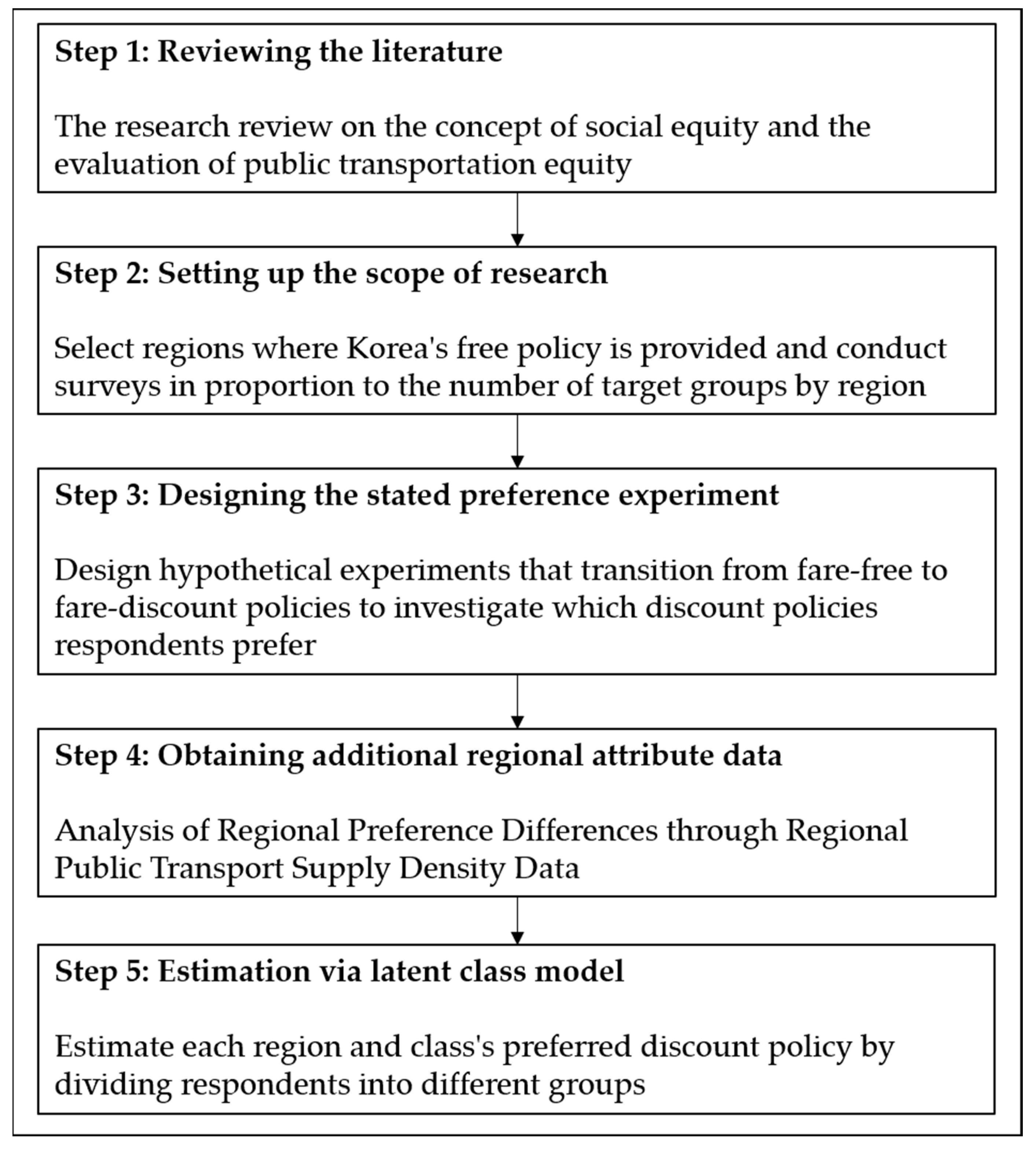
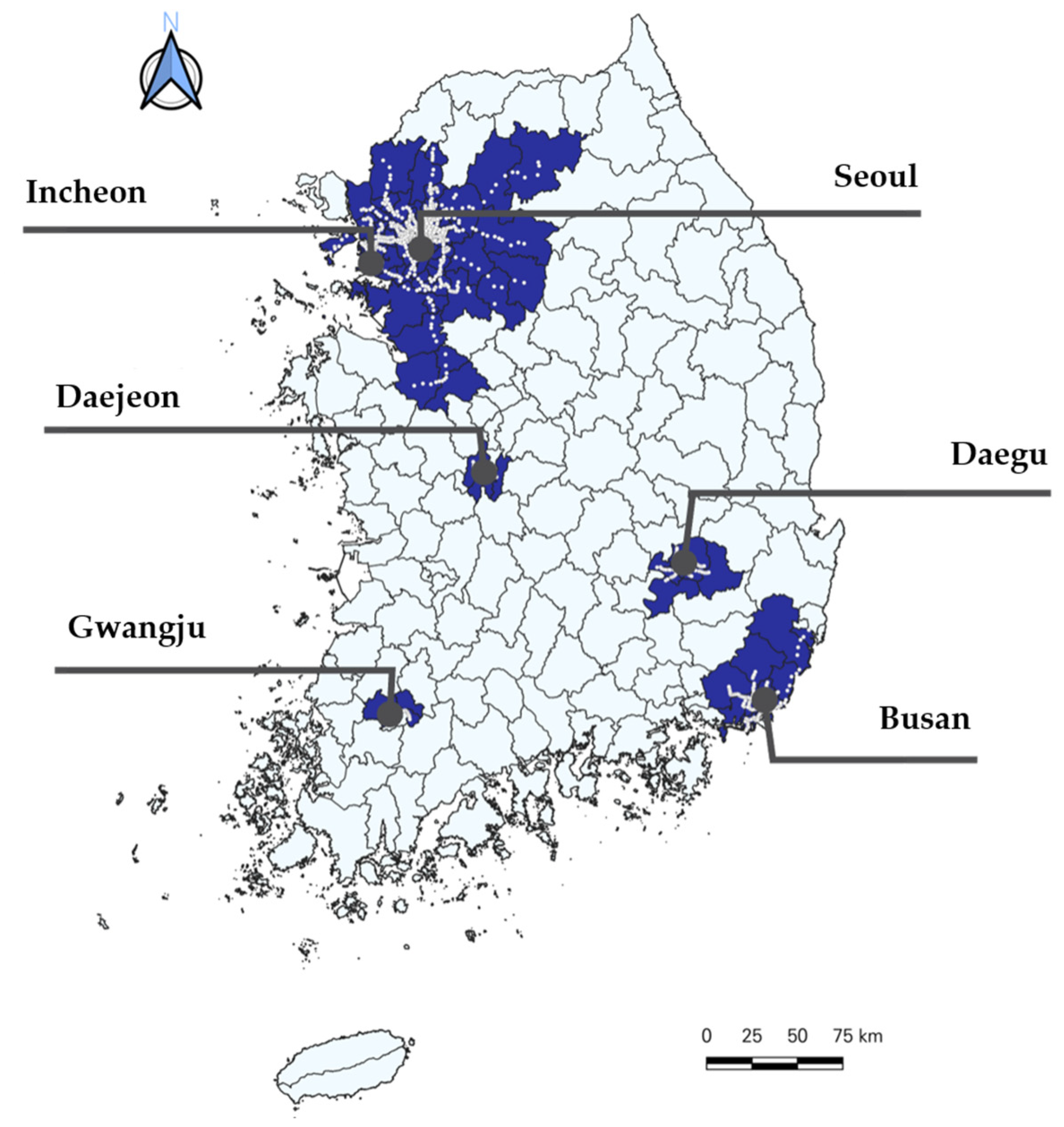
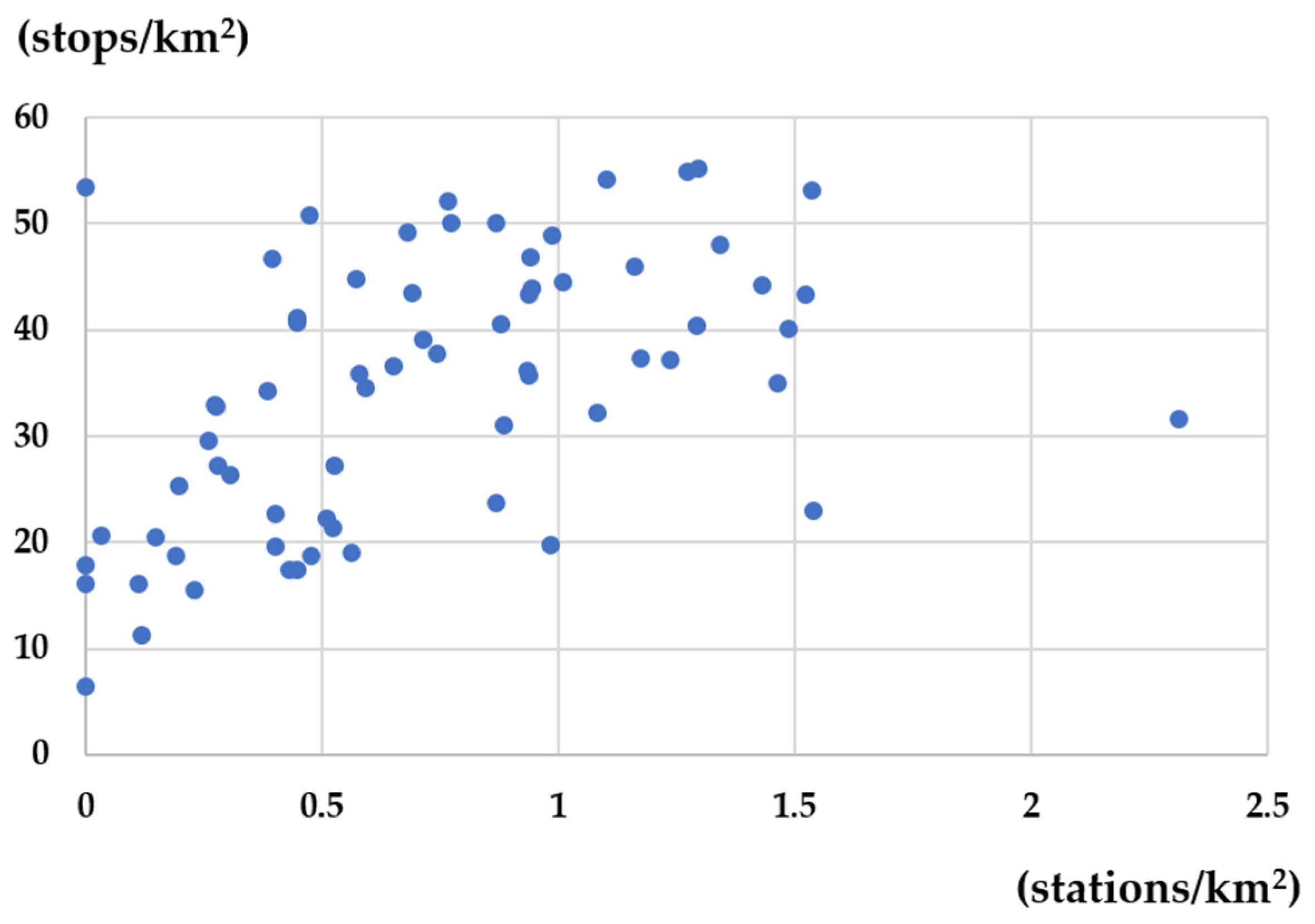
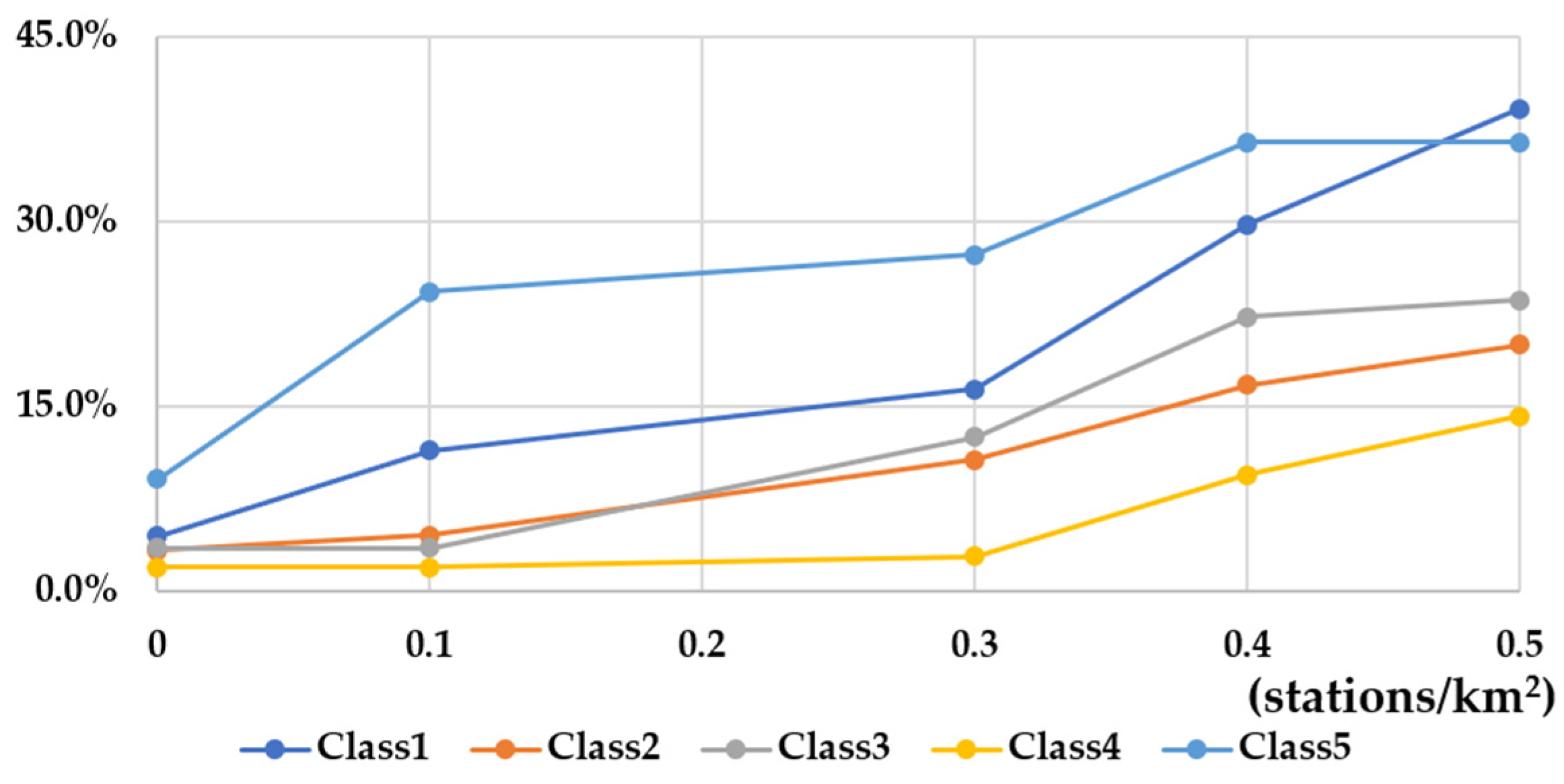
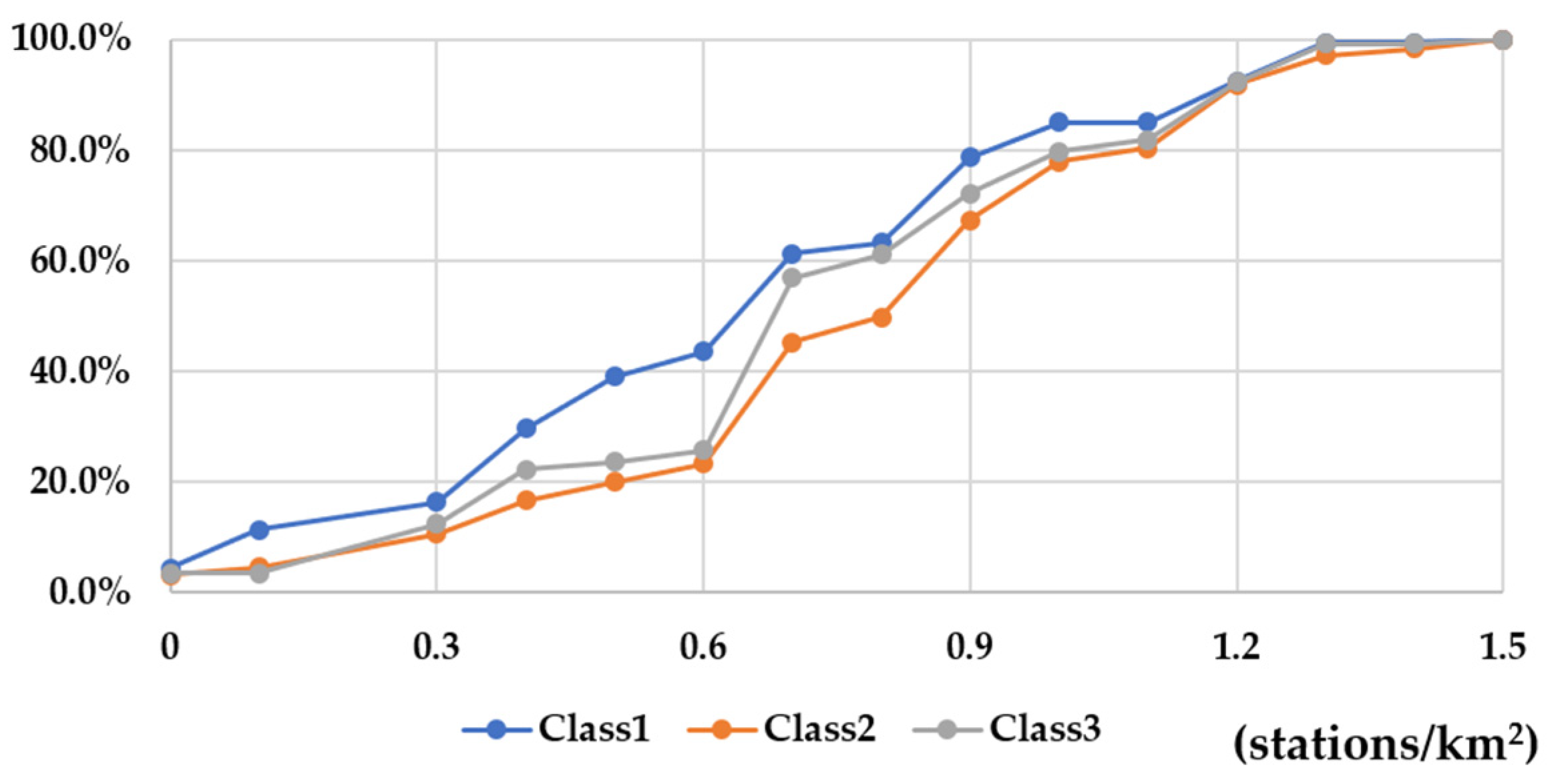
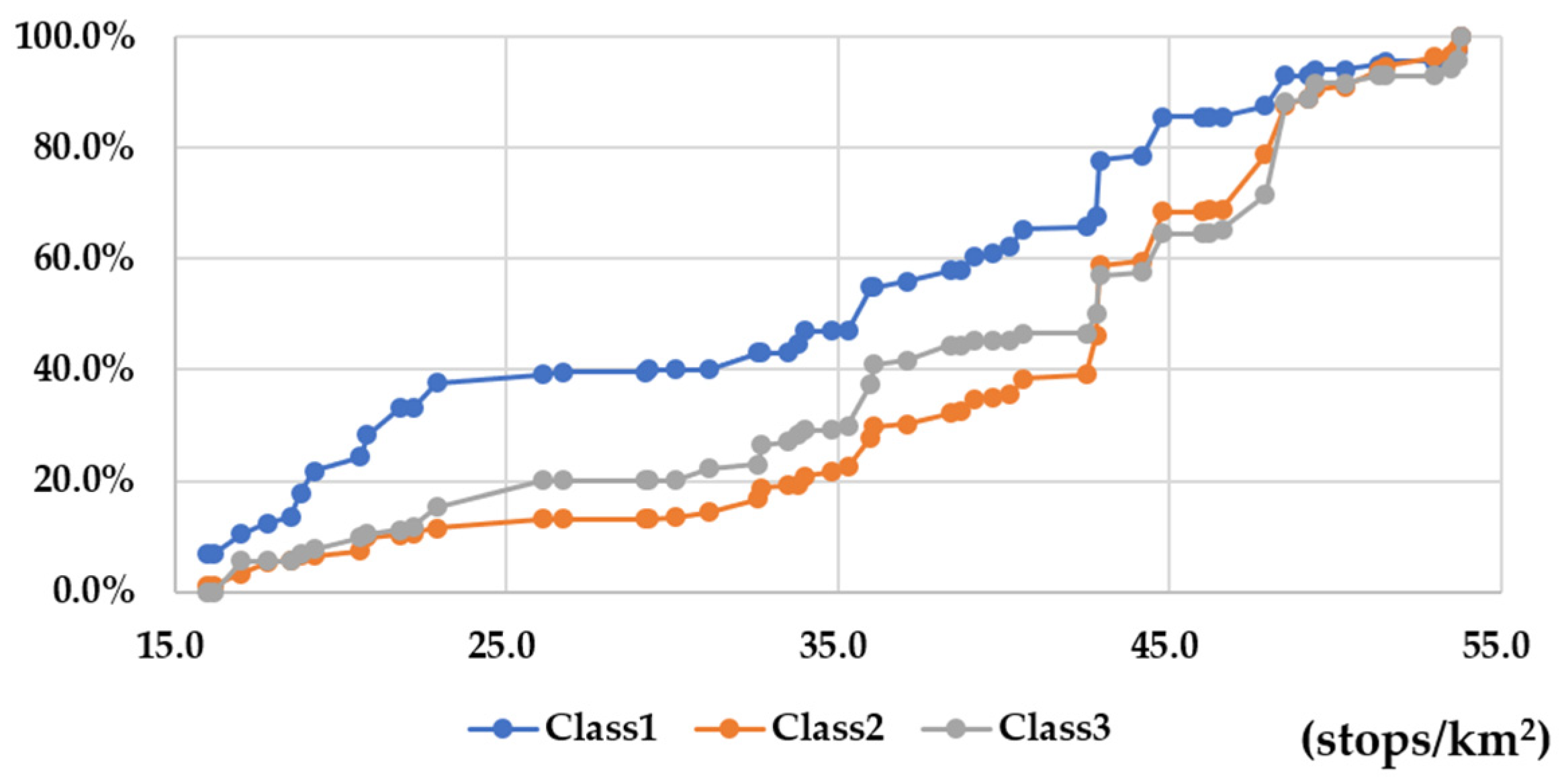

| Variable | Category | Frequency | Distribution (%) |
|---|---|---|---|
| Gender | Male | 391 | 53.6 |
| Female | 339 | 46.4 | |
| Age | between 65 to 69 years | 239 | 32.7 |
| between 70 to 74 years | 196 | 26.8 | |
| between 75 to 79 years | 162 | 22.2 | |
| between 80 to 84 years | 102 | 14.0 | |
| 85 years or over | 31 | 4.3 | |
| Residence | Seoul | 329 | 45.1 |
| Busan | 116 | 15.9 | |
| Daegu | 103 | 14.1 | |
| Incheon | 82 | 11.3 | |
| Gwangju | 50 | 6.8 | |
| Daejeon | 50 | 6.8 | |
| Household income | less than 377.5 USD/month | 57 | 7.8 |
| between 377.5 to 755 USD/month | 172 | 23.6 | |
| between 755 to 1510 USD/month | 230 | 31.5 | |
| between 1510 to 2265 USD/month | 161 | 22.1 | |
| between 2265 to 3020 USD/month | 66 | 9.0 | |
| More than 3020 USD/month | 44 | 6.0 | |
| Employment status | Employed | 205 | 28.1 |
| Unemployed | 525 | 71.9 | |
| Driving status | Driver | 177 | 24.2 |
| Not driver | 553 | 75.8 |
| Attribute | Level |
|---|---|
| Travel cost (USD) | 0.3, 0.6, 0.9 |
| In-vehicle time (min) | 25, 30, 35, 40 |
| Out-of-vehicle time (min) | 5, 10, 15, 20 |
| Attributes | Bus | Subway |
|---|---|---|
| Travel cost | 0.6 USD | 0.3 USD |
| In-vehicle time | 30 min | 25 min |
| Out-of-vehicle time | 20 min | 20 min |
| Choice | □ | □ |
| Variable | Category | Frequency | Distribution (%) |
|---|---|---|---|
| The density of subway stations in urban areas (stations/km2) | less than 0.5 stations/km2 | 3 | 12.0 |
| between 0.5 and 1.0 stations/km2 | 10 | 40.0 | |
| between 1.0 and 1.5 stations/km2 | 9 | 36.0 | |
| between 1.5 and 2.0 stations/km2 | 2 | 8.0 | |
| more than 2.0 stations/km2 | 1 | 4.0 | |
| The density of bus stops in urban areas (stops/km2) | less than 35 stops/km2 | 4 | 16.0 |
| between 35 and 40 stops/km2 | 6 | 24.0 | |
| between 40 and 45 stops/km2 | 7 | 28.0 | |
| between 45 and 50 stops/km2 | 5 | 20.0 | |
| more than 50 stops/km2 | 3 | 12.0 |
| District | The Density of Subway Stations in Urban Areas (Stations/km2) | The Density of Bus Stops in Urban Areas (Stops/km2) |
|---|---|---|
| Seoul | 1.049 | 41.202 |
| Busan | 0.574 | 35.287 |
| Daegu | 0.486 | 17.715 |
| Incheon | 0.438 | 28.612 |
| Gwangju | 0.163 | 17.879 |
| Daejeon | 0.227 | 27.317 |
| Attributes | |
|---|---|
| Discrete choice model part | In-vehicle time, out-of-vehicle time, travel cost. |
| Class membership model part | Age, gender, driving status, employment status, density of subway stations in urban areas, and density of bus stops in urban areas. |
| Number of Classes | Number of Parameters | LL | AIC | BIC | CAIC | ρ2 |
|---|---|---|---|---|---|---|
| 1 | 5 | −2974.169 | 5958.339 | 5981.304 | 5963.339 | 0.340 |
| 2 | 17 | −2698.906 | 5431.813 | 5509.894 | 5448.813 | 0.514 |
| 3 | 29 | −2524.673 | 5107.346 | 5240.544 | 5136.346 | 0.586 |
| 4 | 41 | −2465.915 | 5013.830 | 5202.145 | 5054.830 | 0.651 |
| 5 | 53 | −2414.765 | 4935.530 | 5178.962 | 4988.530 | 0.679 |
| 6 | 65 | −2377.192 | 4884.384 | 5182.932 | 4949.384 | 0.713 |
| Attributes | Class 1 | Class 2 | Class 3 | Class 4 | Class 5 | |||||
|---|---|---|---|---|---|---|---|---|---|---|
| Coefficient | p-Value | Coefficient | p-Value | Coefficient | p-Value | Coefficient | p-Value | Coefficient | p-Value | |
| Constant (Bus) | −0.47313 | 0.029 (*) | −2.23627 | 0.015 (*) | −1.15786 | 0.236 | −3.59877 | 0.000 (***) | 4.39818 | 0.016 (*) |
| Out-of-vehicle time (Bus) (min) | −0.07001 | 0.000 (***) | −0.12609 | 0.003 (**) | −1.06068 | 0.005 (**) | 0.03709 | 0.189 | −0.13042 | 0.157 |
| Out-of-vehicle time (Subway) (min) | −0.09516 | 0.000 (***) | −0.12554 | 0.042 (*) | −1.46962 | 0.003 (**) | 0.00553 | 0.390 | −0.02889 | 0.352 |
| In-vehicle time (min) | −0.03539 | 0.000 (***) | −0.08819 | 0.000 (***) | 0.80961 | 0.014 (*) | −0.01411 | 0.311 | −0.10597 | 0.189 |
| Travel cost (KRW) | −0.00146 | 0.000 (***) | −0.01215 | 0.000 (***) | −0.03457 | 0.001 (**) | −0.00255 | 0.000 (***) | −0.00191 | 0.010 (*) |
| Class shares | 31.3% | 29.5% | 19.2% | 15.6% | 4.4% | |||||
| Attributes | Class 1 | Class 2 | Class 3 | Class 4 | Class 5 | |||||
|---|---|---|---|---|---|---|---|---|---|---|
| Coefficient | p-Value | Coefficient | p-Value | Coefficient | p-Value | Coefficient | p-Value | Coefficient | p-Value | |
| Age (year) | −0.04940 | 0.191 | −0.01926 | 0.353 | −0.03822 | 0.253 | 0.00825 | 0.391 | - | - |
| Gender (male = 1) | 0.63270 | 0.202 | 0.90848 | 0.084 | 0.45444 | 0.277 | 1.05780 | 0.059 | - | - |
| Driving status (driver = 1) | 2.63002 | 0.033 (*) | 1.88400 | 0.111 | 1.55523 | 0.172 | 1.87993 | 0.117 | - | - |
| Employment status (employed = 1) | −0.44045 | 0.292 | −0.21083 | 0.370 | −0.54581 | 0.250 | 0.04605 | 0.398 | - | - |
| The density of subway stations in urban areas (stations/km2) | 1.18972 | 0.126 | 1.08453 | 0.146 | 0.57986 | 0.304 | 2.01482 | 0.016 (*) | - | - |
| The density of bus stops in urban areas (stops/km2) | −0.01056 | 0.361 | 0.04026 | 0.094 | 0.03093 | 0.178 | 0.02912 | 0.206 | - | - |
| Number of Classes | Class 1 | Class 2 | Class 3 |
|---|---|---|---|
| Out-of-vehicle time (Bus)/Out-of-vehicle time (Sub) | 0.73569 | 1.00441 | 0.72174 |
| Out-of-vehicle time value (Bus) (USD/hour) | 2.190 | 0.473 | 1.399 |
| Out-of-vehicle time value (Sub) (USD/hour) | 2.976 | 0.471 | 1.939 |
| District | Class 1 | Class 2 | Class 3 |
|---|---|---|---|
| Seoul | 28.7% | 51.0% | 34.0% |
| Busan | 15.8% | 17.6% | 17.4% |
| Daegu | 13.4% | 14.3% | 25.0% |
| Incheon | 21.3% | 6.5% | 11.8% |
| Gwangju | 14.4% | 2.4% | 2.8% |
| Daejeon | 6.4% | 8.2% | 9.0% |
| District | Class 1 | Class 2 | Class 3 | Class 4 | Class 5 |
|---|---|---|---|---|---|
| Age | 71.7 (5th) | 74.1 (2nd) | 73.7 (4th) | 75.4 (1st) | 74.0 (3rd) |
| Gender (male = 1) | 0.50 | 0.49 | 0.36 | 0.54 | 0.24 |
| Driving status | 0.43 | 0.20 | 0.15 | 0.18 | 0.03 |
| Employment status | 0.32 | 0.25 | 0.19 | 0.26 | 0.21 |
| The density of subway stations in urban areas (stations/km2) | 0.68 (4th) | 0.81 (2nd) | 0.76 (3rd) | 0.92 (1st) | 0.65 (5th) |
| The density of bus stops in urban areas (stops/km2) | 17.19 (1st) | 11.74 (4th) | 13.64 (3rd) | 11.57 (5th) | 14.06 (2nd) |
| Out-of-vehicle time value | 1st | 3rd | 2nd | - | - |
| Class share | 31.3% | 29.5% | 19.2% | 15.6% | 4.4% |
Disclaimer/Publisher’s Note: The statements, opinions and data contained in all publications are solely those of the individual author(s) and contributor(s) and not of MDPI and/or the editor(s). MDPI and/or the editor(s) disclaim responsibility for any injury to people or property resulting from any ideas, methods, instructions or products referred to in the content. |
© 2023 by the author. Licensee MDPI, Basel, Switzerland. This article is an open access article distributed under the terms and conditions of the Creative Commons Attribution (CC BY) license (https://creativecommons.org/licenses/by/4.0/).
Share and Cite
Yun, J. Strategies for Improving the Sustainability of Fare-Free Policy for the Elderly through Preferences by Travel Modes. Sustainability 2023, 15, 14678. https://doi.org/10.3390/su152014678
Yun J. Strategies for Improving the Sustainability of Fare-Free Policy for the Elderly through Preferences by Travel Modes. Sustainability. 2023; 15(20):14678. https://doi.org/10.3390/su152014678
Chicago/Turabian StyleYun, Jaewoong. 2023. "Strategies for Improving the Sustainability of Fare-Free Policy for the Elderly through Preferences by Travel Modes" Sustainability 15, no. 20: 14678. https://doi.org/10.3390/su152014678
APA StyleYun, J. (2023). Strategies for Improving the Sustainability of Fare-Free Policy for the Elderly through Preferences by Travel Modes. Sustainability, 15(20), 14678. https://doi.org/10.3390/su152014678





